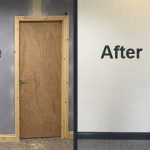Plasterers carry out a variety of jobs and that includes skimming over different surfaces. As the finish and quality of these surfaces can differ, it means that plasterers need to carry out additional prep work.
If plaster is applied incorrectly or the surface is not suitable, then it can lead to the plaster failing. So, when it comes to skimming over surfaces such as artex, it’s important that the right steps are taken to create a perfect finish.
It is possible to skim over artex, but it is crucial that you carry out the right prep work. For a good finish, you will need to ensure that you prime the surface using PVA, and smooth off any points where possible.
Once you complete the prep work, you can then begin applying the plaster to your wall or ceiling. It is important to remember that artex can contain asbestos. Therefore, you’ll need to determine when the artex was applied, or when the property was built.
Is it easier to skim over artex or remove it?

Artex is commonly found in older properties, but it is a finish and look that is no longer in trend. People prefer to have a smooth surface that they can paint or wallpaper. This means most people will want to remove artex or skim over it. Both processes are possible, however skimming over is usually the easiest option.
While it might be tempting to remove artex, it is a time consuming job, that isn’t always necessary. To remove the artex, you will need to use a steamer and a scraper. It is a relatively simple job but can be quite laborious. Also, you will still probably need to skim after if the surface is in a poor condition. This essentially means that you are carrying out two jobs when the same finish can be achieved by simply skimming over the artex.
So, if the artex is firm and there are no loose sections, it is easier to apply a skim coat of plaster over it. This will save time and provide a smooth surface with much less hassle.
What is the easy way to skim over artex?
To successfully skim over artex, you must carry out the necessary prep work. With the right prep work, it will ensure you have a good, smooth finish that will last.
The first thing to do is ensure the surface is in a good condition. This means you should look for any loose sections or damage. If the artex does have damage or is loose, then you should not skim over it. This is because your plaster is likely to crack, and eventually come away from the wall with the loose artex.
You should aim to make sure that the surface is primed and ready to accept the plaster. This will ensure that the plaster can bond to the artex correctly. To begin, you will need to apply two coats of PVA to the artex. This is done using a mix of 2:1 (two parts water and one part PVA).
You will need to wait until the first coat of PVA is dry before you apply the second coat. Once the second coat has dried, you can then scrape away any raised areas using a scraper. This will help to create a smoother finish and you won’t need more plaster to cover any raised areas. Once this has been done, you’re then ready to apply the first coat of plaster.
Is it safe to remove asbestos artex?
If you choose to remove the artex, it is important to find out when the property was built or when the artex was applied. For properties built before 1984, or if it was fitted before, then it could contain asbestos.
If you think the artex does contain asbestos, you should avoid moving it yourself. However, if you feel the need to remove it, you can call in a professional to do it for you. If the property was built after 1984, then the artex won’t contain asbestos and is safe to remove.
Asbestos is extremely harmful, and the fibers can cause long term health problems if you inhale them. Therefore, it is important to call in an asbestos expert to remove it.
An asbestos expert will use all the necessary safety equipment and methods to safely remove it,. However, if you are only looking for a smooth surface you can decorate, you may be better off just skimming. This is often the best choice even if it does contain asbestos.
Conclusion
You can skim artex if its in good condition. This would also be the quickest and easiest way to get a smooth surface. Of course, before you carry out any work on artex, you’ll need to determine whether it contains asbestos.
Should you find it doesn’t contain asbestos, you can skim over it, you could even plasterboard over it. However, as with any job, it is vital that you carry out the right preparation to ensure a good quality finish.




